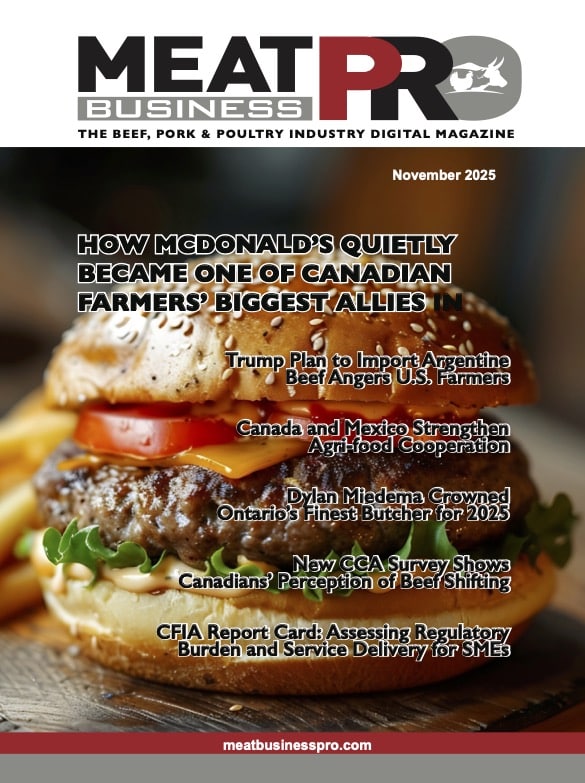FCC Report: Canada’s opportunity to diversify food exports beyond the U.S.

The Canadian agriculture and food industry is a major player in global trade, known for its high-quality and sustainably produced food
Our close relationship with the United States, has been a substantial driver in expanding our trade flows. This strong economic partnership has historically benefited our agriculture and food sector, creating a mutually advantageous trade environment.
Recent U.S. tariffs have introduced uncertainty into that relationship, posing significant challenges for Canadian exporters and strain on producers. The concentration of Canadian exports to the U.S. underscores the sector’s vulnerability to the evolving trade policies of our southern neighbour and a strong need for diversification.
To that end, FCC has created this analysis which focuses on the significant opportunity for Canada to shift a total of $12 billion of Canadian food and beverage exports away from the U.S. market. Diversifying those exports can mitigate trade risks and enhance the resilience of Canada’s agriculture and food system against this and future shocks.
The proposed $12 billion diversification strategy represents approximately one third of Canada’s current food and beverage exports to the U.S. This would reduce U.S. market dependence in food and beverage exports to 50% of 2023 levels.
Our suggested approach to diversification is multifaceted:
Strengthening inter-provincial trade;
Leveraging existing free trade agreements; and
Establishing new international trading partnerships.
While these opportunities exist, we know as well as anyone that they would take time to implement. Regardless, our current economic challenges have focused Canadians like never before on how we can increase prosperity through new strategies and trading partners. We see this publication as a chance to deepen the discussion about how to tackle one of the most important challenges facing the country.
This research includes an analysis on products and markets which FCC believes are prime diversification targets. Our goal is to inform conversations about how Canadian producers might limit trade reliance on the United States.
Together, we can build a more resilient and globally competitive future for the Canadian food and beverage industry, and thus all Canadians.
Current state of agriculture and food trade reliance on the U.S.
Canada’s agriculture and food system is heavily integrated with that of the U.S. In 2023, 68% of Canada’s agriculture and food imports came from the U.S., while 59% of the sector’s exports went south of the border (Figure 1). On the import side, 78% of primary agriculture and 65% of food and beverage came from the U.S. On the export side, only 31% of primary agricultural products were destined for U.S. markets, compared to 76% in the food and beverage category.
Setting trade diversification targets
Canada’s food and beverage export reliance on the U.S. has been growing, increasing from 67% in 2018 to just over three quarters in 2023. Concurrently, the country’s global trade competitiveness has declined: Canada has fallen to seventh from fifth in global agriculture and food trade rankings over the last quarter century. So, there’s a need to both boost global trade competitiveness and diversify trade away from the U.S.
It’s important to note that there is no universal standard for trade diversification, or universally acceptable level of trade reliance on any given trading partner. Context and situational factors – such as geography, trade logistics and specific economic conditions – are important. Generally, over-reliance on any trading partner increases the risks associated with changing political and economic conditions within that partner country.
It’s also important to acknowledge the many factors that make Canada and the U.S. natural trading partners: our proximity, long and shared border, cultural similarities (in food preferences, nutritional guidelines, etc.) and similar regulatory environments – to name a few. We need to keep these factors in mind as we set realistic and attainable targets for greater trade independence from the U.S.
A straightforward target for diversification would be to reduce U.S. market dependence in food and beverage exports to 50%. This would be equivalent to shifting food and beverage exports away from the U.S. by a factor of $12 billion, or by 34% from a 2023 baseline.
We see two ways to meet a targeted 50% export reliance on the U.S.:
Strengthen inter-provincial trade so that sales to the U.S. can be redirected to meet domestic demand, substituting U.S. imports with Canadian products. This would have the added benefit of reducing both exports to, and imports from, the American market. We estimate that approximately $2.6 billion in current food and beverage exports to America could be redirected to meet Canadian demand. This calculation is based on a 50% U.S. import reliance target. We assume that at least half of the import reduction needed to meet this 50% target can be achieved by redirecting Canadian products previously exported to the U.S. to instead meet domestic demand previously filled by U.S. imports.
Strengthen and expand global trade relationships to grow Canadian food and beverage exports beyond the U.S. With inter-provincial trade accounting for $2.6 billion of the $12-billion shift, we estimate that approximately $9.4 billion in current food and beverage exports to the U.S. will need to be re-directed to other markets, such as high-value markets in Europe and rapidly expanding markets in Asia.
Strategies for achieving trade diversity
Promote the “buy Canadian” movement to drive domestic demand for Canadian-made products. Boost domestic demand for Canadian food and beverage products through targeted marketing efforts.
Enhance Canada’s brand abroad. Grow demand for Canadian food and beverage products abroad through branding and marketing that signal the quality, safety and versatility of Canadian food.
Invest in the transportation and logistics infrastructure needed to boost inter-provincial trade. Canada is a vast country – to put it in perspective, a product travelling from one side of Europe to the other would still need to travel an additional 2,800 kilometers to match the distance between Canada’s eastern and western coasts. Infrastructure investments are needed to expand inter-provincial supply chains and improve the flow of food and beverage products across provinces.
Enhance competitiveness. Innovation, boosting the scale of processing and finding efficiencies can drive productivity gains that make food and beverage businesses more competitive. Expanding domestic value-added processing will help ensure that Canada’s food system captures a larger share of the food dollar (rather than exporting primary agriculture outputs to be processed elsewhere).
Diversify product offerings. Explore emerging and niche markets (for example, organic, plant-based proteins, cultural and specialty foods, and sustainably processed/packaged foods). This will open opportunities to explore new markets at home and abroad.
Explore new trade partnerships. Leverage existing trade agreements (there are currently 15 that already give Canada access to 51 countries and 66% of global GDP) and seek opportunities for new partnerships.
Trade diversification opportunities by commodity
Using recent trade data, we’ve identified U.S. trade reduction aims for different food and beverage commodity groups and evaluated the potential to achieve these goals via the two strategies identified above. The 50% import and export reliance targets are aggregate goals, which not all sectors can (or should) contribute to in equal or even proportional amounts. Some commodity groups may need to set more ambitious objectives than others to achieve the aggregate $12-billion reduction in U.S.-bound exports. We considered the relative scale and importance of each commodity to Canada’s current food and beverage trade, current reliance on the U.S. and factors such as perishability. Setting realistic targets for each commodity group is essential to a successful diversification strategy.
We set these targets in two stages. First, we compared import and export reliance objectives to identify the potential to boost inter-provincial trade by substituting goods previously imported from the U.S. with goods previously exported to the U.S. In other words, we suggest re-directing Canadian exports to meet domestic demand via more robust inter-provincial trade. This strategy has the double benefit of reducing both import and export reliance on the U.S.
Secondly, after determining how much of our export diversification target could be achieved by boosting inter-provincial trade, we then identified opportunities to diversify the remaining exports away from the U.S. to other potential global trading partners. For each commodity group we looked at, we identified key countries with growing markets for those goods (based on trade data from 2018 and 2023), where diversification efforts would be best focused.
Animal feed
In 2023, 63% of Canada’s animal feed exports were U.S.-bound. We recommend a reliance target of 50% for this commodity group. Achieving this target will require reducing cross-border animal feed exports by $131 million or 20% from the 2023 baseline.
Animal feed imports from the U.S. were $1.5 billion in 2023, amounting to 87% of total imports in this category. Given such a high degree of import reliance on the U.S., we set a reliance target of 65%. Achieving this target will require reducing animal feed imports from south of the border by $382 million (or 25% from the 2023 baseline).
The reduction in imports needed to meet our reliance target is significantly greater than the reduction in exports needed to meet the export reliance target of 50% – $382 million versus $131 million, respectively. We assume that half of the import reduction needed to meet the import reliance target can come from boosting inter-provincial trade.
This means we could replace up to $191 million in imports from the U.S. with Canadian products. It follows that the full $131 million reduction in exports needed could be achieved by re-directing these sales to fill domestic demand previously filled by imports from the U.S. In other words, the strategy of boosting inter-provincial trade is sufficient for meeting the export reliance goal.
Moving forward in the face of uncertainty: Diversifying trade for a more resilient food system
The evolving global trade landscape represents a significant opportunity for the Canadian food and beverage industry – and thus, the country as a whole. That is, to build a more resilient food system by expanding inter-provincial trade and growing export markets beyond the United States.
This shift will require a collective effort from stakeholders across the food and beverage value chain. There is a pressing need to invest in infrastructure, scale up operations, foster innovation and explore new markets, both within Canada and abroad.
Together, we can transform current trade challenges into opportunity – and lead the way to a resilient and prosperous future for the Canadian food and beverage sector.












